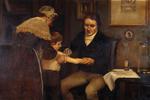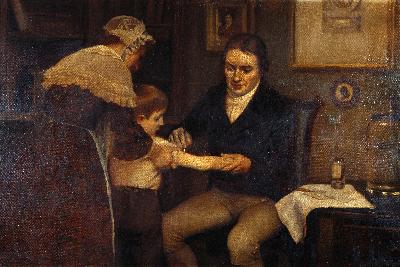Dr Edward Jenner carrying out his first smallpox vaccination on James Phipps, 14 May 1796
Maker and role
Ernest Board (b.1877, d.1934)
Production date
20th Century
See full details
Details
Description
Oil painting, held by the Wellcome Collection
Copyright: Wellcome Collection
Copyright: Wellcome Collection
History
Edward Jenner carried out an experiment in 1796, which led to the discovery of the smallpox vaccine. Jenner took some pus from a cowpox blister on the hand of milkmaid and inoculated it into the arm of an eight-year-old boy, James Phipps. Initially, James developed a scab and experienced some soreness and mild fever. However, when Jenner later exposed James to smallpox to see if he was immune, he found that the boy showed no signs of the disease.
Jenner proved that contracting cowpox provided immunity against smallpox. He called the procedure 'vaccination' after the Latin word for cow 'vacca'. Despite some opposition, vaccination soon became standard practice for preventing smallpox. Thanks to a global eradication programme of mass vaccination, the World Health Organisation officially declared smallpox eradicated in 1980.
What was smallpox?
Smallpox, now eradicated, was a highly infectious and deadly disease that was endemic around the world. Symptoms included feverishness, sickness and diarrhoea, and a rash across the body which developed into fluid-filled blisters. Survivors of the disease were often left blind and with deep pitted scars on their skin. During the 20th century alone, around 300 million people died from smallpox worldwide.
Jenner proved that contracting cowpox provided immunity against smallpox. He called the procedure 'vaccination' after the Latin word for cow 'vacca'. Despite some opposition, vaccination soon became standard practice for preventing smallpox. Thanks to a global eradication programme of mass vaccination, the World Health Organisation officially declared smallpox eradicated in 1980.
What was smallpox?
Smallpox, now eradicated, was a highly infectious and deadly disease that was endemic around the world. Symptoms included feverishness, sickness and diarrhoea, and a rash across the body which developed into fluid-filled blisters. Survivors of the disease were often left blind and with deep pitted scars on their skin. During the 20th century alone, around 300 million people died from smallpox worldwide.
Catalogue Number
150.31
Subject Person and Role
Edward Jenner (b.1749, d.1823)
Subject Person
Subject auto tags
Object Types
Part of 1 highlight set
Share
All images are the property of the British Red Cross Museum and Archives (unless otherwise indicated), and cannot be used without permission. For queries about permission to use images, please contact enquiry@redcross.org.uk.


